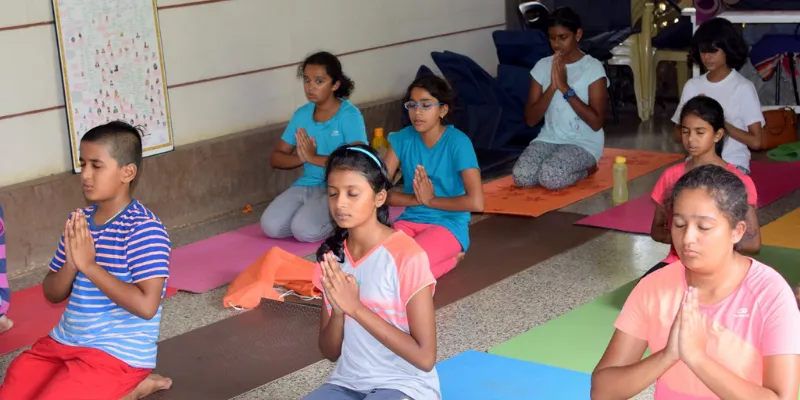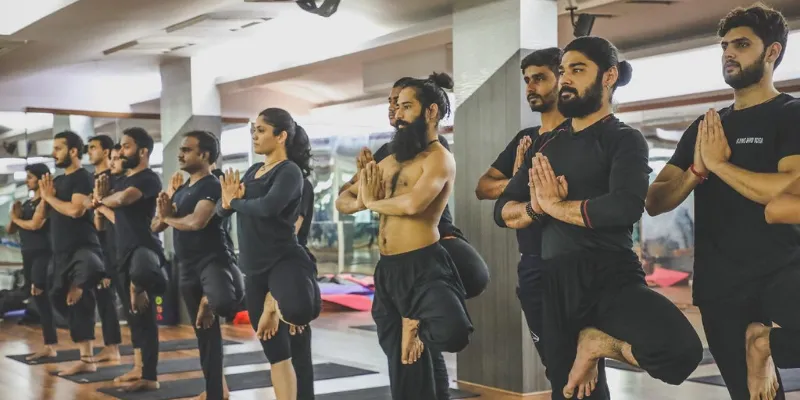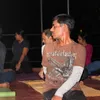International Yoga Day: How a few minutes of stretching and breathing can help you strike a work-life balance
Yoga is not just about burning calories or twisting the body to attain multiple postures. It is a form of fitness that deals with the body, breath, mind, and soul. This International Yoga Day, let’s dig into the science behind the wellness form, and the benefits that can be accrued from it.
At a time when everyone is hustling towards a steady job, a fat pay check, and a well-settled life, many of us tend to undergo a great deal of stress, anxiety, experience emotional turmoil, and even fall prey to unhealthy lifestyles. While exercise fads, overdose of caffeine, and crash diets do make way for momentary relief, they are rarely as enduring as yoga.
Pooja Sriram, a 31-year-old digital marketer, has been juggling babysitting her one-year-old, managing household responsibilities, and meeting deadlines at work. After realising the difficulties involved for a working mother like her, she decided to fend it off by practising yoga regularly.

Pooja Sriram performing the Chakrasana.
“Taking care of a one-year-old and managing a full-time job gets very taxing at times. Yoga is helping me get through this difficult phase. Just a few minutes of stretching, meditation, and breathing exercises is enough to boost my energy levels and keep me going,” Pooja tells YourStory.
One of the oldest forms of exercise, yoga is believed to have originated in India during the pre-Vedic times. It was back in the eighteenth and early nineteenth century that it trickled to different parts of the country and gained acceptance from millions of people. Today, yoga is not only considered a physical exercise, but also one that enhances mental and spiritual capabilities.

A yoga session in progress. (Image: Yoga Bharati, Bengaluru)
As we commemorate International Yoga Day today, YourStory delves into how we can incorporate this ancient practice in our daily lives and benefit from it.
The essence of yoga
Yoga is not all about twisting the body into exquisite poses. It is a practice that is holistic in nature, and includes almost every aspect of existence – right from catching up on some sound sleep, following a nutritious diet, basking in the sunshine to taking deep breaths. The word 'yoga' in Sanskrit means ‘union’ implying it is a science that can connect the body, mind, and soul to attain optimal way of living.
Mickey Mehta, a leading fitness and health guru, with over thirty years of experience in this space, spoke to YourStory about the crux of yoga.
1561037726375.png?fm=png&auto=format)
Holistic health and fitness guru Mickey Mehta.
“According to me, yoga is the ultimate form of wellness. It holds the power to transform negative energies into positive ones and uplift people in the process. Not only does it mould characters and personalities, but also makes way for vitality, patience, equilibrium, flexibility, humility, and dynamism. The essence of yoga can never be expressed fully, and it needs to be practised to be understood,” he says.
Yoga uses a series of breathing techniques and physical practices (asanas) to achieve a deep sense of peace, improved mental fortitude, and an able physical condition. A few minutes of practice on a regular basis is known to do wonders. Whether it is recovering from an injury, enhancing blood circulation, dealing with a disabling condition, or even recouping from a state of depression, yoga has the potential to resolve all these problems.

Grandmaster Akshar (centre) training people in yoga.
ALSO READ

Praveen Hegde (name changed) is a senior employee presently working with a leading data science company in India. A few years ago, he was filled with a host of negative emotions like guilt, apathy, and self-pity. In addition to that, he was constantly sleep deprived and disconnected from reality. All of this, only until he gave himself a second chance through yoga.
“Praveen started attending my yoga sessions and made it a point to practise every single day. Within a span of three months, he transformed to become a more optimistic, confident, and lively individual. Today, he is leading a happy and content life,” says Grandmaster Akshar, Founder, Akshar Yoga.
Different forms of yoga
Yoga is not limited to the traditional form. There are myriad styles of the science and finding the right form to deal with a certain problem might take some time.
Vinyasa yoga is suited for people who are keen on managing their stress. Most of the postures in this form concentrate on breath and movement, almost like a dance. Ashtanga yoga is quite rigorous in nature encompassing several yogic postures.

Breathing is an essential part of the science of yoga.
Iyengar yoga, named after the renowned yogic, BKS Iyengar, mainly involves breath control techniques and using props while performing. Power yoga is an intensive form accompanied with upbeat music and most effective when it comes to losing weight. Sivananda yoga entails 12 asanas based on five principles – breath, relaxation, positive thinking, diet, and exercise. Yin yoga is a meditative practice that is meant to strengthen and vitalise the muscles of the body.
While these are some of the most popular versions of yoga, there are many more variations.
1561038073710.png?fm=png&auto=format)
Mickey Mehta has introduced a new form of yoga called ‘Yo Workout’ in his book Lose Weight, Gain Shape.
For instance, Mickey Mehta talks about a new form of yoga called ‘Yo Workout’ in his book, titled Lose Weight, Gain Shape.
“Yo workouts are slightly different from the usual yoga asanas. They have been designed to address the entire body and bring about a sense of wholeness. Many of the exercises focus on cardio, strength, abs, and muscle activation, and all of them are sure to leave you energised,” he says.
Immaterial of the form of yoga, if asanas and exercises are embraced with dedication, results are sure to show up.
Inculcating the science in daily life
Developing any kind of new habit requires both commitment and perseverance. A good way to start off is to keep spare time during the day to fuse yoga into the routine. This could then be done on a repeated basis.

Yoga is a form of fitness that requires no equipment, and can be practised anywhere.
Yoga requires no equipment, and can be practised anywhere. Hence, different asanas and breathing techniques can be performed without any constraints, even within the confines of office walls. Joining a yoga class is also an option that many explore since it tends to provide an atmosphere of mutual learning.
“Every minute that is spent practising yoga is sure to enrich people’s life. I would suggest about 10 to 15 minutes of meditation, followed by pranayama and some basic yet effective asnas like surya namaskar, pawan mukta asana, tadasana, and naukasana. This will surely lead to a healthy body, magnify blood circulation, and keep one at stead,” explains Mickey.
The oomph factor
Life is all about finding the right balance between what we have to do and what we want to do. During the course of this, stress inevitably becomes a part of our being. Yoga calls for paying attention to every nook and corner of our body and mind to attain strength, peace, and harmony.

Yoga holds the power to transform negative energies into positive ones.
“Yoga is a gift to mankind. It transports people to higher levels of functioning by putting them on the path to wellness and tranquility. Just like how a machine needs to be serviced in order to keep it going, we humans need this science to remain up and running,” Grandmaster Akshar explains.
So, this International Yoga Day, let us make an attempt to improve our mental, physical and spiritual health by integrating and recognising this science.











